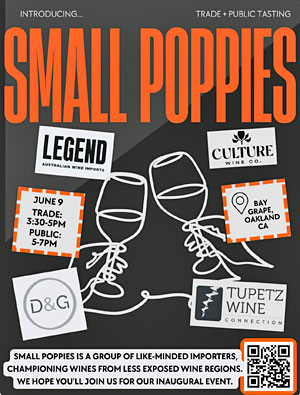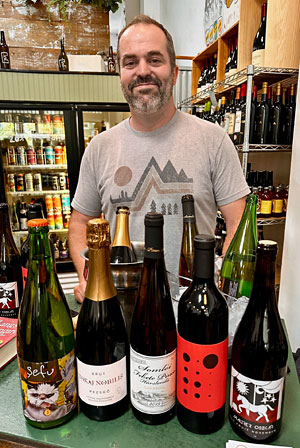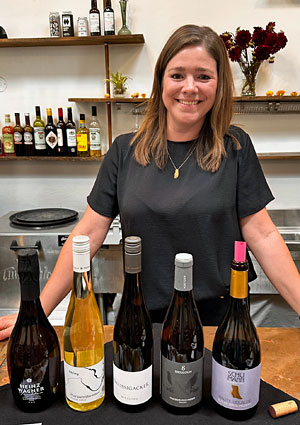Small Poppies Wine Tasting – June 9, 2025
I recently attended the first tasting of the Small Poppies Collective, held at Bay Grape wine shop in Oakland. The collective is currently made up of four importers “who are passionate about wines from lesser-known and less-appreciated corners of the wine world.” The owners / co-owners of the four importers were on hand at the tasting to pour a selection of their wines for trade and media in the afternoon and for the public later in the day.
The four importers who poured their wines at the Small Poppies Collective tasting were:
Culture Wine Co. (wines of South Africa) – Peter Andrews
Danch & Granger Selections (wines of Central and Eastern Europe) – Eric Danch
Legend Imports (wines of Australia) – Jane Lopes
Tupetz Wine Connection (wines of Germany) – Lisa Tupetz
I was already familiar with two of these importers and had heard good things about the other two so I was looking forward to this tasting, and it definitely didn’t disappoint. Bay Grape co-owners Cameron Hoppas and Lara Pearce did a fine job of setting up four tasting stations in their shop, with plenty of space for attendees, and there was also a selection of bread, cheese, and charcuterie set out in another part of the shop.
Legend Imports
I started out at the Legend wine table. There are plenty of cheap Australian wines sold in the US, but far fewer “serious” wines from there, particularly the truly terroir-driven wines that are not as widely available here. Jane co-authored a book with her husband and business partner Jonathan Ross that has recently been published, titled “How to Drink Australian.” Jane poured a diverse group of wines at her table:
Seppeltsfield 2023 Watervale Riesling from Clare Valley in South Australia
Chalmers 2022 “Mother Block” White Blend from Heathcote in Victoria (mostly Vermentino plus Fiano, Greco, and more)
Patrick Sullivan 2023 Chardonnay from Limestone Coast/Henty in Victoria
Murdoch Hill 2021 Syrah from Adelaide Hills in South Australia
Vino Volta 2023 “Post Modern Seriousism” Grenache from Swan Valley in Western Australia
The Seppeltsfield 2023 Watervale Riesling was a favorite here, featuring bright citrus and stone fruit aromas plus a toned-down petrol element, with medium body and a lively, dry finish. The Chalmers “Mother Block” showed that Italian grape varieties can work very well in Australia. Jane noted that the Murdoch Hill 2021 Syrah from the estate vineyard is labeled as “Syrah” rather than “Shiraz” to help consumers understand that the fruit comes from a cooler-climate location than most Australian Shiraz bottlings. This wine was one of the day’s highlights for me, and definitely displayed that cooler-climate character, with savory herbal aromas along with plum and darker berry fruit plus touches of pepper and black olive, with a chalky tannic finish.
Danch & Granger Selections
Next for me were the wines from Danch & Granger. Eric and his business partner Catherine Granger have been standard-bearers for years for importing terrific wines from Central and Eastern Europe. These regions include a great diversity of wine traditions, so it’s not surprising that their wines are made in a wide variety of styles. And it wasn’t surprising that Eric selected a fascinating group of wines to pour:
Edgar Brutler 2023 Sefu White Field Blend from Transylvania in Romania (co-fermented field blend of four varieties)
Tokaj Nobilis 2019 Furmint Pezsgő Brut from Tokaj in Hungary
Fekete Béla 2019 “Gold Edition” Hárslevelű from Somló in Hungary (dry white wine with botrytis)
Piquentum 2021 Teran from Istria in Croatia
Oszkár Maurer 2022 “Red Fruit November” from Subotičko in Serbia (dry Cabernet Sauvignon with botrytis)
The Edgar Brutler 2023 Sefu was one of the standouts here – made mostly in stainless steel, it’s a fun wine with stone fruit, herb, and floral notes with vibrant acidity. I also really enjoyed the Tokaj Nobilis 2019 Furmint Pezsgő Brut, a lightly sparkling wine from Tokaj made with no botrytis. Eric poured both a dry white and dry red made from botrytized fruit – both were intriguing and distinctive, and the Fekete Béla 2019 “Gold Edition” Hárslevelű was one of my favorites of the entire tasting. Aged first in old puncheons and then for four years in tank prior to bottling, the wine featured aromas of honey, petrol, tropical fruit, and savory herbs, with medium body and a great balance of acidity and residual sugar, plus a super long finish.
Tupetz Wine Connection
I moved on to the Tupetz wine table. Lisa Tupetz is originally from Germany and is now based on California’s Central Coast. Most American wine consumers are familiar with only a small number of German wines – if they’re familiar with them at all – so this was a good opportunity to taste a broader range of wines from a country that’s the eighth-largest wine producer in the world. Lisa poured these wines at her table:
Heintz Wagner 2021 “Tradition” Sparkling Wine from Baden/Black Forest (60% Pinot Noir, 40% Chardonnay)
Margarethenhof Nicolas Weber 2023 “Der Spritzige” Elbling from Mosel/Saar
Dreissigacker 2022 Estate Riesling from Rheinhessen
Dreissigacker NV “Vintages” Riesling from Rheinhessen (from 2017-2022 vintages)
Siegloch 2020 “Vogelfrei” Weissburgunder Trocken from Württemberg (Pinot Blanc)
Weinhaus Bettina Schumann 2018 “Haute Volaute” Blauer Spätburgunder from Baden/Kaiserstuhl (Pinot Noir)
I particularly enjoyed both Riesling bottlings – the Dreissigacker 2022 Estate Riesling displayed more upfront petrol aromas with the residual sugar just outpacing the acidity, while the Dreissigacker NV “Vintages” Riesling had more a more subdued petrol note, with stony mineral quality and a nearly bone-dry finish. My favorite wine at this table was the Nicolas Weber 2023 “Der Spritzige” Elbling, featuring bright pear and spice aromas plus earth and a lightly floral note, with fine balance, lively acidity, and a slight spritz – a bit tough to describe but very distinctive and one of the standout wines of the afternoon for me.
Culture Wine Co.
The final wines of the afternoon for me were from Culture Wine Co. South Africa is the world’s largest producer of Chenin Blanc – and they’re also known for Rhône varieties – while the wines that Peter poured here featured a wider diversity of the country’s wines. He also set out on his table small stones from the vineyards for each of the wines he poured to show the variety of soil and rock types.
Brookdale Estate 2024 Mason Road Chenin Blanc from Paarl
Maanschijn 2023 “Herbarium” from Walker Bay in Stellenbosch (Sauvignon Blanc, Sémillon, Chenin Blanc, Chardonnay)
Klein Amoskuil 2024 “Qvevri” Skin Contact White from Swartland (Sémillon, Sauvignon Blanc, Chenin Blanc)
Van Hunks NV “Cap Classique” Brut from Stellenbosch (70% Chardonnay, 30% Pinot Noir)
Scions of Sinai 2024 “Atlantikas” Pinotage from Stellenbosch
The Brookdale Estate 2024 Chenin Blanc was a highlight here, with its citrus, apple, and herb aromas, great acidity, and chalky texture. I thought the very herbal and stone fruit character of the Maanschijn 2023 “Herbarium” was also particularly notable, while the Klein Amoskuil 2024 “Qvevri” was my favorite at this table. Each variety in this blend was left on the skins in qvevri for six months before pressing and then only the free run used for further aging in qvevri for this wine. Upfront herb, earth, and spice components with subdued stone fruit notes, moderate tannin, and a very clean finish – perhaps the cleanest qvevri wine I’ve ever tried, and one of the afternoon’s real standouts.
I really enjoyed this tasting, and I appreciated the broad spectrum of varieties and styles on display from the four importers. Thanks to all four of the importers who poured their wines at this inaugural Small Poppies tasting, as well as to Bay Grape for hosting it. I hope this becomes a regular event – it was a terrific opportunity to taste these fine wines coming from overseas wine regions that don’t always get a lot of attention here in California.
[Additional Reviews & Journals from Ken Zinns]
|






